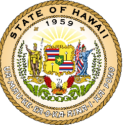Hawaii is the most recent territory to become a state. In 1959, just a few months after Alaska, the Territory of Hawaii achieved statehood. It was the culmination of half a century of work.
The Kingdom of Hawaii
Hawaii’s history, like that of each of the 50 states, is unique. In 1810,
King Kamehameha brought all the islands together into one royal kingdom. Throughout the 19th century, people came to Hawaii from other places and gained power there. In 1887, the incomers forced King Kamehameha to accept a new constitution that reduced his power and took rights away from native Hawaiians.
Queen Lili’uokalani, the next and final ruler of the Kingdom of Hawaii, rewrote the constitution in 1893 to establish her power. She was overthrown by the powerful business interests who had established themselves by that time. President Grover Cleveland established a commission that decided that the overthrow was illegal, but the United States had no authority over Hawaii, and Queen Lili’uokalani never regained her kingdom.
The Kingdom of Hawaii lasted just 83 years.
The Republic of Hawaii
Instead, Hawaii became the Republic of Hawaii. Texas and California were also Republics before they became states. The United States, Great Britain, and France all had their eyes on Hawaii. The sugar industry was dominated by Americans, and Samuel Dole (of Dole XXX) was very powerful. Many in the U.S. worried that a European power would make Hawaii into a colony and gain the strategic and economic advantages that would come from that.
In 1889, just about a decade before United States acquired Puerto Rico from Spain, the U.S. annexed Hawaii with the support of the business community there. By 1900, Hawaii was named a territory of the United States, and Samuel Dole was appointed governor. The U.S. was flirting with imperialism at the time, with some leaders wanting to follow the example of Great Britain by gaining land all over the world.
The United States never did become an imperial power, and the Empires of the 19th century fell apart as the 20th century brought independence to former colonies around the world. We cannot guess what would have happened to Hawaii if it had been colonized by France or England, but President Clinton apologized in 1993 for the U.S. complicity in the overthrow of the monarchy.
Hawaii was essentially ruled by a small group of businessmen, and the businessmen liked it that way. But the native Hawaiians and other people who were not part of that powerful group wanted something different. They could see that statehood would give them more power. They could elect their own governor and have a voice in Washington, where they had only a non-voting commissioner, just like the rest of the territories. Hawaii requested statehood in 1903.
The State of Hawaii
Like so many other territories, Hawaii continued to request statehood for many years. Congress passed a number of statehood bills, but the Senate didn’t vote on them. Hawaii was a Republican territory at the time, and the
U.S. State Department says that party politics and racist attitudes delayed Hawaii’s admission into the Union.
By 1959, when Hawaii became a state, the native Hawaiian population was small. Statehood, which had originally been desired by the powerless in Hawaii, signaled the end of a dream some Hawaiians held of becoming a monarchy again. While the majority of the people wanted statehood, some worried that statehood would mean the end of traditional Hawaiian culture.
Of all the former territories, Hawaii is the one we most often get comments about, comments suggesting that statehood was bad for Hawaii. We can’t say whether being a monarchy would be better than being a state, but we can say that this is not the question. By the time Hawaii was admitted to the Union, they had been a territory for half a century. There was no realistic chance of returning to the Kingdom of Hawaii.
As a territory, Hawaii was powerless in the United States. The Big Five corporations had most of the power in the Territory, and most of the people were living in poverty. Being a state brought prosperity, and an
increase in the population of native Hawaiians after a century of decline. The native Hawaiian culture did not disappear.
Being a state was much better than being a territory. Hawaii’s
economy zoomed ahead and it is now one of the most prosperous states in the Union.
Lessons for Puerto Rico
Puerto Rico was never a kingdom or a republic. Puerto Rico was a colony of Spain for 400 years. While there was a brief attempt at
greater home rule during that colonial period, Puerto Rico never gained independence from Spain. Puerto Rico has never voted for independence from the United States and has never elected an Independence Party governor.
There are people who have a wistful desire for independence for Puerto Rico — especially when they live a state. There are also people who still yearn for a
special relationship with the Unites States, something that won’t be covered by the
Territory Clause. These are not realistic desires. Puerto Rico doesn’t want independence, and the United States won’t agree to a special relationship.
Just as Hawaii’s real choice was between becoming a state and remaining a territory, Puerto Rico’s real choice is between becoming a state and remaining a territory. With many more Puerto Ricans living in the 50 states than in Puerto Rico, it should be clear that fears of losing the traditional Puerto Rican culture are unrealistic.
Tell your legislators that you support statehood for Puerto Rico. Help them be on the right side of history.


No responses yet